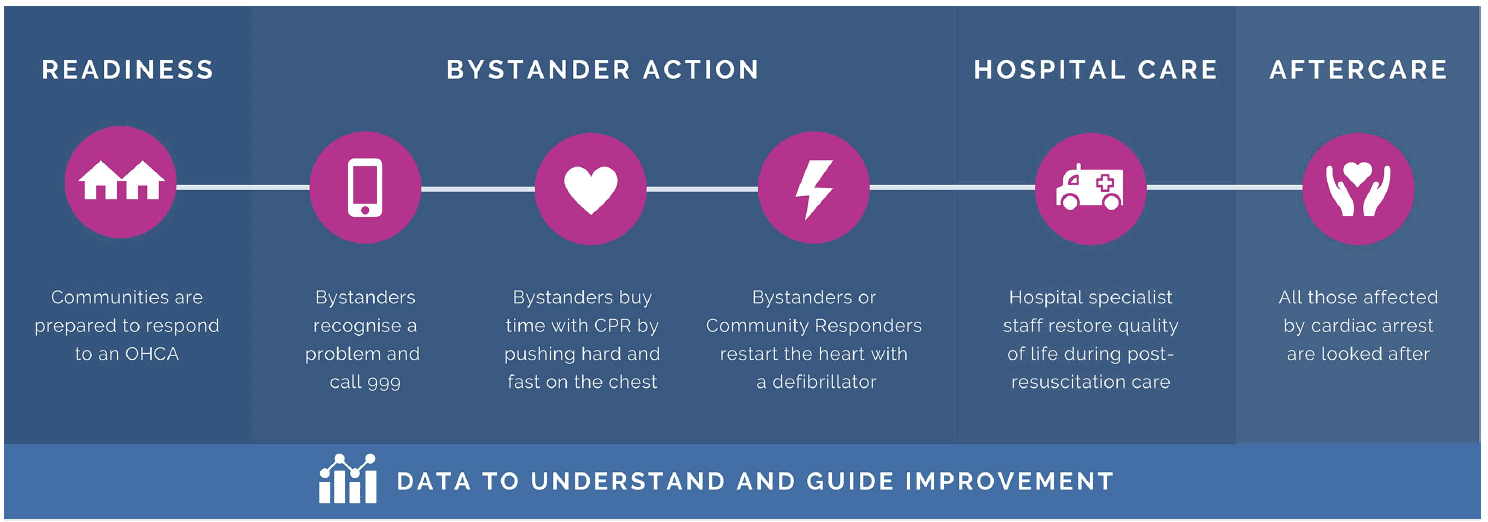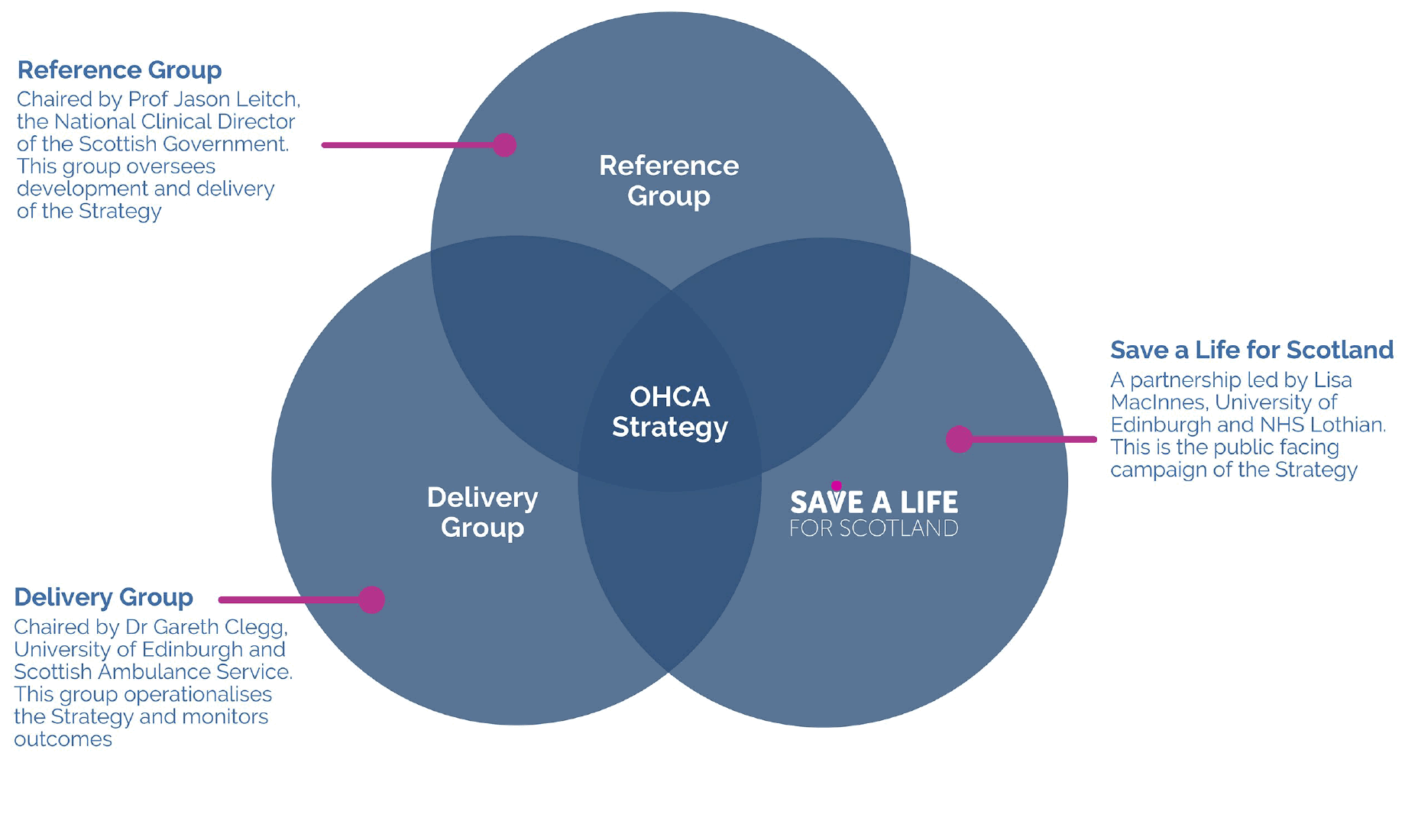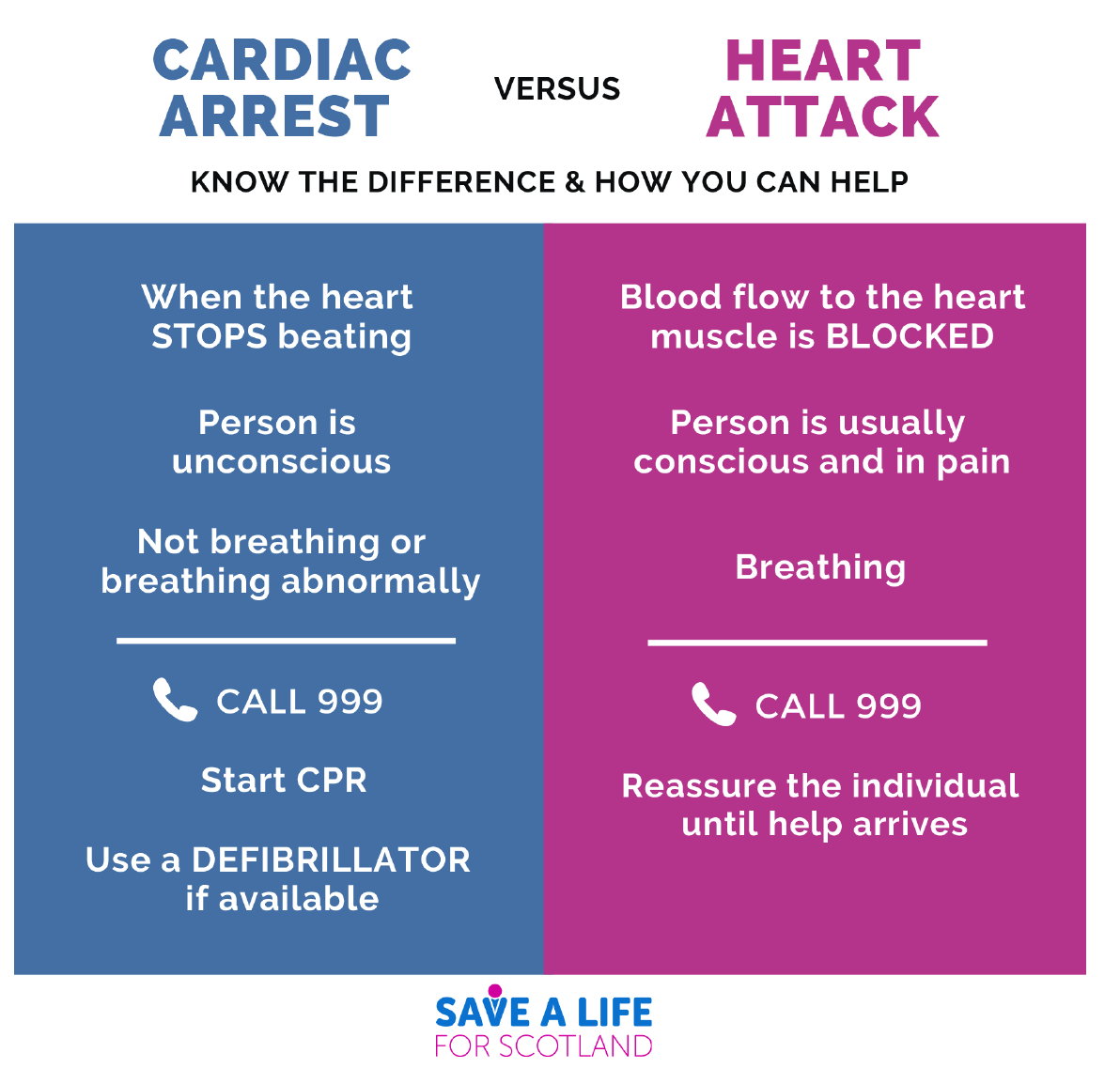Out of hospital cardiac arrest: strategy 2021 to 2026
Scotland’s out-of-hospital cardiac arrest (OHCA) Strategy 2021 to 2026 reflects progress made since throughout the lifetime of the previous strategy (2015 – 2020), and sets out the next steps we will take to ensure as many people as possible survive an out-of-hospital cardiac arrest in Scotland.
2. Introduction
Scotland's Out-of-Hospital Cardiac Arrest Strategy 2021-2026
Each year in Scotland over 3,000 people have resuscitation attempted in the community after they have a cardiac arrest[1]. This is known as an Out-of-Hospital Cardiac Arrest (OHCA). Unfortunately only 1 in 10 people survive such an event[2].
We know from other countries around the world, with similar populations and healthcare systems, that it is possible for more people to survive. In some places 25% of people who have an OHCA will survive to leave hospital[3][4].
With this refreshed strategy, we intend to further increase survival after OHCA in Scotland.
The inaugural Out of Hospital Cardiac Arrest Strategy (2015-2020)
In 2014 Michael Matheson, then Scottish Government Minister of Public Health, brought together a Reference Group including emergency services, third sector organisations, community groups and academics. This group developed the 'Out-of-Hospital Cardiac Arrest, A Strategy for Scotland 2015 - 2020'[5]. That strategy was launched by Maureen Watt, Minister for Public Health, in 2015.
Since 2015, significant progress has been made.
We achieved our aim of equipping an additional 500,000 people living in Scotland with CPR skills, and survival after OHCA has increased significantly. Before the launch of the first Strategy in 2015, only around 1 in 20 people survived to leave hospital after OHCA. By 2020 this number had doubled to 1 in 10[6].
Our approach was also recognised as best practice by international bodies including the Global Resuscitation Alliance[7].
Foundational to the success of the original strategy, was the adoption of the 'Scottish Approach' to cross-sectoral working: "a focus on outcomes, co-production (at an organisational level), using and sharing assets (primarily organisational assets) and [adopting] a system-wide approach"[8].
More detail on the achievements of the Out-of-Hospital Cardiac Arrest, A Strategy for Scotland 2015 – 2020 can be found in the end of strategy report at savealife.scot/2015strategyreport .
It takes a system
Saving lives after OHCA requires a whole system of care. The necessary sequence of events starts with community readiness and bystander action, continues with trained community responders and paramedics, and ends with in-hospital care and aftercare on returning to the community. This time-critical sequence is often described as the Chain of Survival[9] (Figure 1).
Prioritising early links in the Chain of Survival
The 2015 – 2020 strategy placed particular emphasis on activities at the start of the Chain of Survival, such as bystander CPR. We sought to consolidate and amplify work already being carried out by community groups and third sector organisations across the country to increase rates of bystander CPR in Scotland.
To achieve this, key stakeholders came together to form the Save a Life for Scotland (SALFS) partnership.
Save a Life for Scotland
Save a Life for Scotland (SALFS) is a campaign which brings together the work of a range of partners committed to saving lives by changing the way we think about OHCA in order to get Scotland CPR ready.
It is a collaboration between the emergency services, third sector organisations, Scottish Government and academic researchers. The partnership is directed by the Resuscitation Research Group at the University of Edinburgh. A full list of the partners can be found in the Strategy Partnership section.
The key strategic aims of SALFS are promoting CPR readiness in young people and across a range of communities and shaping perceptions of OHCA among people living in Scotland. The emphasis we place on the importance of this work is visible as an additional 'readiness' link at the start of what the 2015 OHCA Strategy described as the 'augmented Chain of Survival'[10].
In addition to the public facing work of SALFS, Delivery Group partners worked together on a range of interconnected projects to improve OHCA survival nationally and regionally.
We intend to carry forward the same model of partnership working into the next phase of our plan.
Next steps for SALFS
SALFS wishes to build on the successes of the 2015 – 2020 strategy and to address inequalities that we know exist in outcomes from OHCA.
We know from our data linkage reports and from other sources of information, such as the Scottish Health Survey[11], and original research from the University of Edinburgh[12],[13] that there are certain groups we need to make sure we reach through the implementation of this refreshed strategy.
Scope of Scotland's Out-of-Hospital Cardiac Arrest Strategy 2021-2026
This strategy addresses the needs of those who experience, or may witness, a cardiac arrest outside of a hospital setting.
We aim to support partners and other organisations to build on what already works well, to identify and address gaps in provision, and to introduce innovative ideas to meet the aims of this strategy.
This strategy document does not address cardiac arrests in children, or those caused by external physical injury (so called 'traumatic' cardiac arrests). Both of these types of cardiac arrest are far less common than those caused by medical conditions in adults, and require a different approach to their management.
The issue of preventing heart disease, which can lead to cardiac arrest, is covered by other Scottish Government plans, more detail of which can be found in Annex A.
Cardiac arrest can affect anyone, of any age at any time or place. People of all cultural and religious backgrounds and all walks of life. This means that those affected by OHCA have a wide range of experiences. We are committed to listening to and learning from these experiences.
The Chain of Survival
We continue to structure the aims and actions of this strategy on the Chain of Survival, supported by examples of international best practice, for example those summarised in the Global Resuscitation Alliance Call to Action[14].
The following chapters address the 6 elements of the augmented Chain of Survival. The elements, which work together to give people the best possible chance of survival after an OHCA are as follows:
- Getting Scotland OHCA Ready
- Bystander Action
- Call 999
- CPR
- Defibrillation
- Hospital care
- Aftercare
We have also included a Data and Innovation chapter which outlines the data-led approach we will take to improve the Chain of Survival.
A chain is a good metaphor for the series of events required to improve a person's chances of survival from OHCA. It is a reminder that individual elements have a reduced value if the links preceding and following are not also strong. In particular, those actions at the beginning of the Chain are especially important[15]. These are described below under the umbrella category of Bystander Action.

Partners to the Strategy
We would like thank the following partners for supporting the development of Scotland's Out-of-Hospital Cardiac Arrest Strategy 2021-2026, and for their commitment to delivery of the strategy:
Scotland's Out-of-Hospital Cardiac Arrest Strategy 2021-2026 was conceived by a collaboration of organisations committed to improving outcomes for those affected by OHCA. These partners form the Save a Life for Scotland campaign.
- British Heart Foundation
- British Red Cross
- Chest Heart and Stroke Scotland
- Defence Medical Services (Scotland)
- East Neuk First Responders
- Lucky2BHere
- Police Scotland
- Resuscitation Council UK
- Resuscitation Research Group, University of Edinburgh
- Royal Life Saving Society UK
- Scottish Ambulance Service
- Scottish Fire and Rescue Service
- Scottish Government
- St Andrew's First Aid
- St John Scotland
The role of the Save a Life for Scotland partnership is to engage as the public face of the strategy. It is led by Lisa MacInnes, Resuscitation Research Group at the University of Edinburgh.
Delivery Group
The strategy Delivery Group is responsible for implementing the strategy and monitoring the outcomes. This group is chaired by Dr Gareth Clegg, University of Edinburgh and Scottish Ambulance Service. Delivery Group Partners include:
- British Heart Foundation
- British Red Cross
- Chest Heart and Stroke Scotland
- Convention of Scottish Local Authorities (COSLA)
- Defence Medical Services (Scotland)
- Police Scotland
- Resuscitation Research Group, University of Edinburgh
- Scottish Ambulance Service
- Scottish Fire and Rescue Service
- Scottish Government
- St John Scotland
Reference Group
The strategy and its delivery is overseen by the out-of-hospital cardiac arrest Reference Group, which is chaired by Prof Jason Leitch, the National Clinical Director of the Scottish Government. It includes representatives from the Delivery Group partners.
Writing Group
The writing group which led on the development of the strategy on behalf of SALFS partnership are as follows:
- Gareth Clegg, University of Edinburgh, NHS Lothian and Scottish Ambulance Service
- Lisa MacInnes, University of Edinburgh and NHS Lothian
- Liz Hasseld, University of Edinburgh
- Diane Lac, University of Edinburgh
- Jean Skelton, University of Edinburgh
- Becki MacPherson, Scottish Government
- John Wilson, Scottish Government
- Allan Cowie, Chest Heart and Stroke Scotland
- Jim Ward, Scottish Ambulance Service
- Steven Short, Scottish Ambulance Service
- Naz Lone, Scottish Intensive Care Society Audit Group
- Mark Dunn, NHS Lothian
- Dave Bywater, Scottish Ambulance Service
- Richie Hall, Scottish Fire and Rescue Service
- Sarah Smith, Chest Heart and Stroke Scotland
- Angus Loudon, St John Scotland
- Liz Crawford, St John Scotland
External expert feedback
We would like to thank the following subject matter experts for their comments on drafts of the strategy document:
- Deafblind Scotland
- Marcus Ong, Duke-NUS Medical School and Health Services Research Institute Singapore
- Katie Dainty, University of Toronto
- Gillian Moreton, Lifelines Scotland
- Sudden Cardiac Arrest UK
In addition, strategy partners would like to offer their sincere thanks to the individuals and organisations who attended consultation events and offered their feedback. We also extend our thanks to the ALLIANCE, who facilitated a lived experience engagement event.
We would also like to thank Claire Fleck Photography for supplying the photograph for the front cover.

Covid-19
Consideration of the short and long-term impact of the Covid-19 pandemic.
It is impossible to publish this strategy without considering the impact of Covid-19.
We know that people who witness an OHCA may have concerns around Covid-19 transmission. The ask of bystanders to perform CPR or defibrillation is a big one, especially in the midst of a pandemic, and it is not one that we make lightly.
Since the launch of the inaugural Out-of-Hospital Cardiac Arrest Strategy in 2015, the position of Save a Life for Scotland has been that hands-only CPR is the most appropriate course of action during a cardiac arrest in adults. This continues to be our recommendation during the Covid-19 pandemic.
SALFS have updated our CPR guidance to reflect Covid-19 appropriate actions. This now includes covering the mouth and nose for the person in cardiac distress with a loose cloth.
Health inequalities, already significant in Scotland, have increased during the pandemic as Covid-19 has had a disproportionate impact on people living in areas of socioeconomic deprivation, and on people from Black, Asian or minority ethnic backgrounds.
This reinforces the importance of our efforts to address inequality in outcomes from OHCA.
Throughout the pandemic the Scottish Ambulance Service has continued robust data collection at the scene of OHCA. This will enable analysis of the impact of the pandemic on OHCA and help us to robustly assess future planning implications.
During the development of this refreshed strategy, we considered the potential impact of Covid-19 on the aims of the strategy. In particular, we considered whether it would be appropriate to reduce the targets in anticipation of the challenges of recovering from the pandemic.
However, we have not done so as we view the implementation of this strategy as important in the recovery from the Covid-19 pandemic and it is important to us that we do not minimise our aims. This is reflected in the ambitious aims and actions of this strategy.

Contact
Email: Clinical_Priorities@gov.scot
There is a problem
Thanks for your feedback